There are six meridians that begin or end in the fingers of the hands. They all pass through the shoulder or armpit. The Yin Yoga practice does not often target these lines. [1] The six upper body meridians are the Heart, Small Intestine, Large Intestine, Lung, Pericardium, and San Jiao.
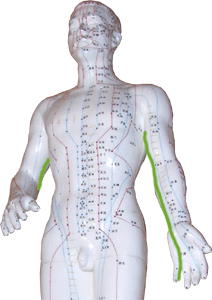 The Heart Meridian
The Heart Meridian
The three branches of the Heart meridian begin in the heart. One branch flows downward through the diaphragm to meet the small intestines. Another rises up alongside the throat and ends in the lower eye. The third runs across the chest, through the lungs, and comes out through the armpit. It flows along the midline of the inside upper arm, through the inner elbow, along the midline of the inner lower arm, until it crosses the wrist and palm, before ending in the inside tip of the little finger where it connects to the Small Intestine meridian.
Disorders of the heart and chest such as palpitations, pain, insomnia, night sweats, and mental problems may signal problems with the Heart meridian.
 The Small Intestine Meridian
The Small Intestine Meridian
Starting where the Heart meridian ends, the Small Intestine meridian begins at the outer tip of the little finger. It runs along the back edge of the hand, through the wrist, upward along the outer forearm and upper arm, to the shoulder. After circling the back of the shoulder, it meets 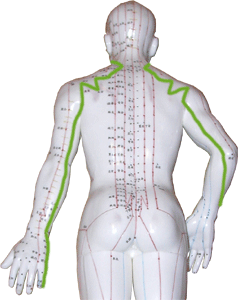 the Governor Vessel meridian. Here it branches, with one branch going inside the body and descending through the heart, diaphragm, and stomach before ending in the small intestine. Another branch ascends along the side of the neck to the cheek and outer corner of the eye from where it then goes to the ear. Another small branch leaves the cheek to run to the inner eye where it meets the Urinary Bladder meridian.
the Governor Vessel meridian. Here it branches, with one branch going inside the body and descending through the heart, diaphragm, and stomach before ending in the small intestine. Another branch ascends along the side of the neck to the cheek and outer corner of the eye from where it then goes to the ear. Another small branch leaves the cheek to run to the inner eye where it meets the Urinary Bladder meridian.
Disharmony in the Small Intestine meridian may be indicated by ear, eye, or stomach problems such as deafness, pain in the lower abdomen, or pain in the shoulders or neck.
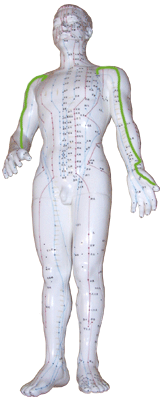 The Lung Meridian
The Lung Meridian
The Lung meridian begins inside the belly just above the navel, and drops down to the large intestines. From here it comes back up through the diaphragm and connects to the stomach. It ascends through the lungs and follows the throat before coming to the front surface of the shoulder from under the clavicle. From here it runs along the outer, thumb side (medial/radial) of the upper arm and the front (anterior) of the lower arm. It crosses the wrist and ends at the outer tip of the thumb. A small branch goes from the wrist to the tip of the index finger, where it connects to the Large Intestine meridian.
Respiratory problems like coughs, asthma, and chest pains may signify Lung meridian dysfunction. Extreme and persistent sadness and grief may also indicate problems here.
 The Large Intestine Meridian
The Large Intestine Meridian
Beginning at the tip of the index finger, the Large Intestine meridian runs between the thumb and forefinger and along the outside (lateral side) of the arm. It comes over the outside top of the shoulder and along the back of the shoulder blades to the spine. Here it branches, with one branch descending through the lungs, diaphragm, and the large intestines. The second branch ascends along the neck and the lower cheek, and enters the lower gum, circling the lower teeth. On the outside, this line also circles the upper lips, crosses under the nose and rises up to join the Stomach meridian.
Problems in the mouth, teeth, nose, and throat such as toothaches and sore throats, as well as problems with the neck and shoulders, may indicate disharmony of the Large Intestine meridian.
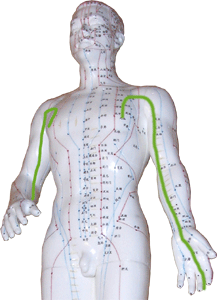 The Pericardium Meridian
The Pericardium Meridian
The pericardium covers the heart and is considered in Chinese medicine to be an organ function of its own. The Pericardium meridian begins in the chest and connects to the pericardium. From here it moves down the chest, connecting the three sections of the San Jiao meridian. Another branch moves horizontally across the chest, coming to the surface of the ribs, moves up and around the armpit and down the front of the bicep and forearm to the palm, and ends at the tip of the middle finger. A small branch leads from the palm to the tip of the ring finger where it connects to the San Jiao meridian.
Pain in the heart area, poor circulation, some stomach problems, and mental problems may indicate disharmony of the Pericardium meridian.
 The San Jiao Meridian
The San Jiao Meridian
The San Jiao meridian is often called the “Triple Burner” or “Triple Energizer.” It begins in the ring finger where the Pericardium meridian ends. It runs over the back of the hand, the wrist, and lower arm. It passes the outer point of the elbow and the back (lateral) of the upper arm to 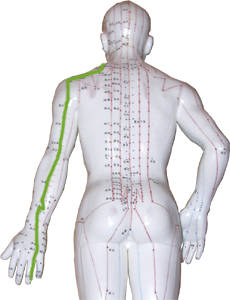 the back (posterior) shoulder. From here it comes over the shoulder to the front of the body and enters the chest beneath the sternum. Here it branches, with the main branch running to the pericardium and continuing down through the diaphragm to the three burners: upper, middle and lower. The second branch ascends along the side of the neck, circles the back of the ear and then circles the side of the face. Another small branch emerges from the back of the ear and connects to the Gall Bladder meridian at the outer corner of the eye.
the back (posterior) shoulder. From here it comes over the shoulder to the front of the body and enters the chest beneath the sternum. Here it branches, with the main branch running to the pericardium and continuing down through the diaphragm to the three burners: upper, middle and lower. The second branch ascends along the side of the neck, circles the back of the ear and then circles the side of the face. Another small branch emerges from the back of the ear and connects to the Gall Bladder meridian at the outer corner of the eye.
Problems associated with the San Jiao meridian may occur in the side of the face, neck, or throat, or in the abdomen. Examples could include deafness, ringing in the ears, bloating, and urinary difficulties.
- — Sometimes, when in a reclining pose, the student may choose to bring her arm or arms over her head and this will stimulate one or more of these upper bodylines. However, for many students, having the arms raised over the head cuts off the flow of blood and energy to the hands. This results in a pins-and-needles feeling, which is not desirable. In those cases the arm should be brought lower.
(Next: The Extra Meridians )
